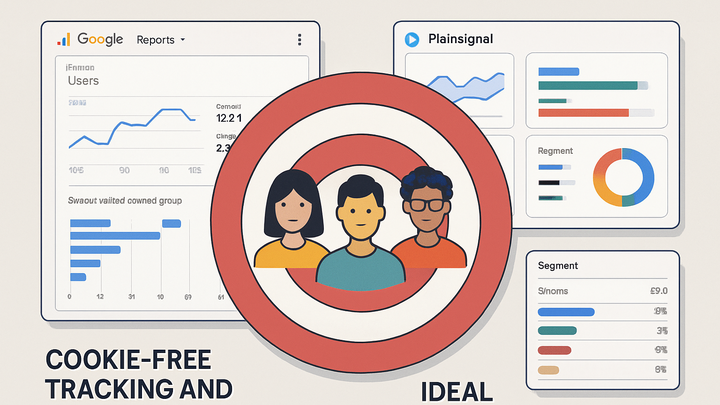Published on 2025-06-27T19:30:18Z
What is ICP? Examples of an Ideal Customer Profile
An Ideal Customer Profile (ICP) is a detailed description of the type of company or user most likely to benefit from and purchase a product or service. ICPs include firmographic details (e.g., industry, company size, or location), technographic fit, and behavioral indicators that signal high conversion and retention potential. In analytics, defining an ICP allows teams to segment web traffic, tailor marketing messages, and prioritize high-value leads. By integrating ICP criteria into platforms like Google Analytics 4 (GA4) and PlainSignal, businesses can filter data, build custom audiences, and uncover insights specific to their target segment. A well-defined ICP maximizes marketing ROI, streamlines sales efforts, and enhances long-term customer satisfaction. Regularly reviewing and updating the ICP based on performance metrics ensures continued alignment with evolving market conditions and business goals.
Icp
Ideal Customer Profile (ICP) outlines the perfect customer type for your business, guiding analytics segmentation and targeted marketing efforts.
Definition and Context
This section explains the core concept of ICP in the analytics domain and sets the stage for its applications.
-
What is icp?
An Ideal Customer Profile (ICP) is a detailed description of the type of company or user most likely to benefit from and purchase a product or service.
-
Key icp characteristics
ICPs are composed of attributes like firmographics, technographics, and behavioral signals that collectively define high-value prospects.
-
Firmographic data
Industry, company size, location, and revenue metrics that outline the structural profile of a target company.
-
Technographic data
Technology stack and software usage patterns indicating compatibility and integration potential.
-
Behavioral signals
Engagement metrics such as website activity, feature usage, and content interactions reflecting interest level.
-
Importance of ICP in Analytics
Understanding ICP helps align analytics efforts with strategic business goals, ensuring data-driven decision-making focuses on the right audience.
-
Alignment across teams
Establishes a unified target definition for marketing, sales, and analytics teams, reducing confusion and improving collaboration.
-
Optimized resource allocation
Allows organizations to concentrate budgets and campaigns on prospects with the highest conversion and retention potential.
-
Enhanced data insights
Enables the creation of targeted segments in analytics platforms, leading to more relevant reports and actionable insights.
Defining Your ICP
A structured process for building an effective ICP by leveraging data analysis, research, and iterative validation.
-
Gather data sources
Utilize CRM systems, customer surveys, website analytics, and third-party databases to collect information on existing top-performing customers.
-
Identify patterns and filters
Analyze collected data to uncover common firmographic, technographic, and behavioral attributes that distinguish high-value accounts.
-
Firmographic data
Attributes like industry sector, number of employees, and annual revenue.
-
Technographic data
Details on the software and hardware environment in use.
-
Behavioral signals
User actions such as page visits, demo requests, and feature engagement.
-
-
Validate and refine
Test ICP assumptions by comparing predicted high-value accounts with actual performance data, adjusting criteria as needed.
Using Analytics Tools to Identify ICP
Configuration and features in GA4 and PlainSignal that support segmentation and tracking based on ICP criteria.
-
Google analytics 4 (GA4)
Leverage GA4’s Audience Builder, custom dimensions, and event parameters to tag and segment visitors matching your ICP.
-
Audiences
Create dynamic audiences based on domain, geography, or custom events.
-
Custom dimensions
Capture additional metadata like customer tier or industry tags.
-
Exploration reports
Analyze behavior patterns for segmented audiences using GA4’s exploratory analysis tools.
-
-
PlainSignal
Implement PlainSignal’s cookie-free analytics to track privacy-compliant data, then filter by domain or custom IDs to isolate ICP traffic.
-
Snippet setup
Add the preconnect and script tags to your site header to enable data collection.
-
Api configuration
Use PlainSignal’s API to send custom properties like account IDs or vertical segments.
-
Privacy compliance
Benefit from built-in anonymization without relying on cookies.
-
-
Comparative insights
Understand differences in data sampling, user-level tracking, and privacy between GA4 and PlainSignal to choose the best tool for your ICP strategy.
Implementation Example
A practical demonstration of how to set up tracking code and analytics configurations for capturing ICP-relevant data.
-
PlainSignal tracking snippet
Integrate the following code into your website to enable PlainSignal’s cookie-free ICP tracking:
-
Preconnect link
<link rel="preconnect" href="//eu.plainsignal.com/" crossorigin />Initiates an early connection to the PlainSignal CDN for improved performance. -
Script tag
<script defer data-do="yourwebsitedomain.com" data-id="0GQV1xmtzQQ" data-api="//eu.plainsignal.com" src="//cdn.plainsignal.com/plainsignal-min.js"></script>Loads the PlainSignal analytics library with your site ID.
-
-
GA4 custom dimensions and events
Define and implement custom dimensions and events in GA4 to mirror ICP attributes, such as account domain or industry category.
-
Event setup
Use the GA4 event tagging interface or gtag.js to send ICP-related event parameters.
-
Custom dimensions
Configure new dimensions in the GA4 admin panel to store ICP metadata for reporting.
-
Best Practices and Common Pitfalls
Guidelines for maintaining an accurate and actionable ICP, along with mistakes to avoid during the process.
-
Avoid overfitting
Resist the urge to make your ICP so narrow that it excludes viable prospects, which can hinder growth opportunities.
-
Regular reviews
Reevaluate ICP criteria periodically—especially after market shifts or new product launches—to keep it aligned with current realities.
-
Respect privacy regulations
Ensure all data collection and segmentation methods comply with GDPR, CCPA, and other applicable privacy laws.
